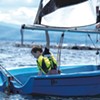Published January 7, 2009 at 6:22 a.m.
For many Vermonters, staying inside during the winter is as agonizing as being a sick kid on a snow day. But now that lift tickets cost more than a couple of tanks of gas, skiing and snowboarding are starting to seem like special-occasion rather than every-weekend sports.
Hinesburg resident Dan Simkins has a suggestion — rather than paying big bucks to ski at a resort, the 46-year-old mechanical engineer recommends “snorkeling.” That’s backcountry skier jive for unmarked powder so deep you’d need a snorkel to breathe in it.
Simkins loves backcountry shredding when the snow is high enough to roll over his shoulders. The fact that it’s free is nice, too.
Nicknamed “Danimal” by his backcountry buddies for his aggressive style, Simkins first tried the adventure sport during the emergence of the last recession in the early 1990s, but not necessarily in response to it.
“I was totally bored with alpine skiing,” he says. “We would duck into the woods looking for powder, and back then it wasn’t really kosher to ski in the woods. The Ski Patrol would chase you out or take your lift tickets away. We were rebels, you know.”
So Simkins opted for telemark skis and the backcountry, which freed him from the constraints of lift-service skiing and gave him access to the “stash” — ungroomed, un-skied powder.
“The beauty is, you can bend your knees and ankles and put your knee all the way to the ground,” he says of telemarking. “It adds a whole new degree of freedom. You have total mobility. And when you start experiencing absolute untracked powder in the middle of the woods, it’s worth it, especially at zero cost. We call it helicopter-style skiing without the helicopter.”
But busting up a 1000- to 2000-foot pitch without a lift will always be taxing, maybe not on the wallet, but certainly on the body — especially in several feet of snow. Like other backcountry powder-heads, Simkins fastens climbing skins on the bottom of his skis to ease the hike. The nylon skins prevent backward sliding, allowing his tellies to act like snowshoes. According to “Danimal,” the skins run roughly $100, but used ones can be purchased for cheap on telemark websites.
When the conditions are right, Simkins treks up and skis down a pitch three or four times in a day, sometimes several days a week. So, while many skiers are weathering blistering winds on crowded lifts, Simkins is most likely breaking through fresh powder on a steep Vermont mountain face, miles away from crowded, icy runs and long lines.
“You have access from wherever you parked to wherever you’re going to ski,” he explains. “You drop down the pitch; then you work your way back up that same pitch, zigzagging back and forth the whole way. You’re usually very happy to find another skin track — we call it the railroad. You get on the railroad and, oh, boy.”
The thought of the hike can be daunting enough to dissuade others from switching from lift-service to backcountry. But with the current state of the economy, Simkins says he wouldn’t be surprised to see more able-bodied ski bums making the transition.
“The sport has been exploding for 10 years,” he says. “The equipment has gotten to the point where it’s much more accessible for people. It’s gotten popular, and a lot of people like me have just gotten bored with the lift-service experience. Even snowboarders are looking for more.”
To Simkins, lift-service will always be a carnival — “an experience for the masses” as he puts it, complete with fee. Unless he is helping his 5-year-old learn how to ski, resorts are usually his last resort. It’s the insatiable hunger for pristine powder and new runs that keeps him in the woods, out of the ordinary — and thrifty.
“It’s really just about the quality of skiing,” he says. “Getting out in the state forest, absolutely in the middle of the woods, nobody around for miles, just playing and having a ball.”
Got a story about how you're getting by? Email [email protected].
Tips Up:
“Danimal” weighs in on backcountry logistics
Check out TelemarkTips.com for discounted gear and info.
“The first thing to do is master telemark skiing, and for that the best thing is probably lift-service to get comfortable. After that you just get out and experience it.
“You’re looking for any north-facing slope along the mountains, because the trees grow thinner, there’s less brush and much more open woods, and snow stays a lot deeper on the north side, as well.” Danimal frequents the backsides of Mad River Glen, Bolton and Camel’s Hump. But, like any respectable backcountry skier, he won’t divulge any more.
“Skiing down through the woods is not for everybody; you have to be an accomplished skier. There’s thick snow, trees, and you’ve got to be careful because there’s a lot underneath the snow, so you’re always holding back a little bit unless there’s a really good base. It is dangerous.” Bringing a buddy — and a means to get help from the outside world — is recommended.
More By This Author
Speaking of...
-

Michael Krasnow Has Spent Decades Giving Kids Skis, Snowboards and a Taste of Independence
Jan 31, 2024 -

Video: Ice Fishing for Rainbow Smelt in Plymouth With Zachary and Fisher McNaughton and Fish Biologist Shawn Good
Feb 9, 2023 -

Video: Gail and George Africa of Vermont Flower Farm Plan to Retire
Sep 8, 2022 -

Under New Ownership, Turtle Fur Plans to Expand Its Offerings
Aug 1, 2022 -

Video: Musicians Jeremiah and Annemieke McLane Move into their New Home
Mar 24, 2022 - More »
Comments
Comments are closed.
From 2014-2020, Seven Days allowed readers to comment on all stories posted on our website. While we've appreciated the suggestions and insights, right now Seven Days is prioritizing our core mission — producing high-quality, responsible local journalism — over moderating online debates between readers.
To criticize, correct or praise our reporting, please send us a letter to the editor or send us a tip. We’ll check it out and report the results.
Online comments may return when we have better tech tools for managing them. Thanks for reading.












































